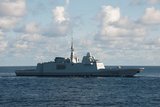New upgraded version of SPEED software released
A new version of the Systems Planning, Engineering and Evaluation Device (SPEED) software developed by Northrop Grumman for the US Marine Corps has been released that enhances electromagnetic spectrum situational awareness and operations.
The US Marine Corps released the update, Version 11.1.1, in July. The new version adds 3D mapping and mission planning capabilities, including frequency-dependent rejection interference analysis, enhanced jammer modelling and effectiveness prediction. The enhancements will enable communications planners to plan, model and analyse radio and jammer effects in a defined electromagnetic spectrum environment to better understand where communications degradation or interoperability issues may occur.
Although developed for the US Marine Corps, SPEED is also used by other US services, in joint operations, and has been supplied to a number of nations through the US foreign military sales programme. The system has been in continuous operation since it was first delivered in 1988.
Mike Twyman, sector vice president and general manager of the Defense Systems division for Northrop Grumman Information Systems, said: ‘Northrop Grumman is proud of its development and advancement of this critical planning capability, particularly as the electromagnetic battlefield grows increasingly complex and the use of the electromagnetic spectrum becomes increasingly essential to warfighters.
‘This recent software release is especially important because it represents significant advancements in both front-end user experience and back-end modelling and simulation. This software provides critical integrated functionality that can support both marine corps and army spectrum management and electronic warfare requirements.’
More from Digital Battlespace
-
![Babcock nears first customer for Nomad AI translation tool]()
Babcock nears first customer for Nomad AI translation tool
Nomad can provide militaries with real-time intelligence, saving critical time on the battlefield.
-
![AUSA 2025: Israel’s Asio Technologies to supply hundreds of improved Taurus tactical systems]()
AUSA 2025: Israel’s Asio Technologies to supply hundreds of improved Taurus tactical systems
Taurus operates alongside the Israel Defense Forces’ Orion system which supports mission management across tens of thousands of manoeuvring forces, from squad leaders to battalion commanders.
-
![AUSA 2025: Kopin pushes micro-LED plans as China moves faster]()
AUSA 2025: Kopin pushes micro-LED plans as China moves faster
The plan for the new displays follows fresh investment in Kopin’s European facilities by Theon and an order for head-up displays in fielded aircraft, with funding from the US Department of Defense.
-
![AUSA 2025: Persistent Systems to complete its largest order by year’s end]()
AUSA 2025: Persistent Systems to complete its largest order by year’s end
Persistent Systems received its largest ever single order for its MPU5 devices and other systems earlier this month and has already delivered the 50 units to the US Army’s 4th Infantry Division.
-
![Aselsan brings in dozens of companies and systems under the Steel Dome umbrella]()
Aselsan brings in dozens of companies and systems under the Steel Dome umbrella
Turkey has joined the family of countries attempting to establish a multilayered air defence system with government approval in August 2024 for the effort landed by Aselsan. Dubbed Steel Dome, the programme joins Israel’s Iron Dome, the US Golden Dome, India’s Mission Sudarshan Chakra and South Korea’s low-altitude missile defence system.
-
![DSEI 2025: MARSS unveils new agnostic multidomain C4 system]()
DSEI 2025: MARSS unveils new agnostic multidomain C4 system
MARSS’ NiDAR system has been deployed using sensors from static platforms to provide detection and protection for static sights, such as critical infrastructure, ports and military bases.




























